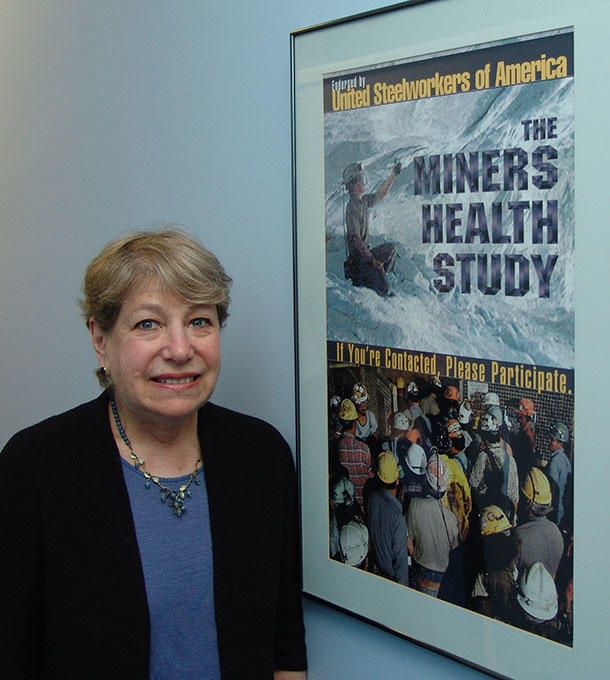Debra Silverman to Retire from the NCI After Over 50 Years
, by Jennifer K. Loukissas, M.P.P.
Debra T. Silverman, Sc.D., former Director of the Occupational and Environmental Epidemiology Branch (OEEB) and senior investigator in the Division of Cancer Epidemiology and Genetics, will retire in November, after over 50 years of service and 16 years leading OEEB. Dr. Silverman dedicated her career to investigating occupational, environmental, and host factors associated with cancers of the bladder, lung, and pancreas. She has directed highly influential epidemiologic studies, yielding definitive answers on the causes of these malignancies. Her work resulted in the classification of diesel exhaust as a human lung carcinogen, which affected regulatory actions around the world, and identified arsenic contamination in drinking water as the cause of excess bladder cancer mortality in New England, leading to remediation efforts.
Early in her career, Dr. Silverman calculated the first national estimates of occupational-induced bladder cancer in the U.S. and has continued to identify and characterize those carcinogenic exposures. She designed and directed the New England Bladder Cancer (NEBC) study, which revealed that arsenical pesticides used in orchards over the first half of the twentieth century persisted in soil and contaminated drinking water from private wells. This discovery explained a decades-long excess of bladder cancer mortality. The NEBC study continues to provide meaningful insights with molecular and genetic studies and investigations of carcinogens with widespread exposure such as disinfection byproducts. As an NCI principal investigator of a hospital-based case-control study of bladder cancer in Spain, Dr. Silverman clarified the role of suspected occupational carcinogens and the associations with a variety of non-occupational exposures, including the higher risks with long-term exposure to trihalomethanes in drinking water and acidic urine, and the lower risks with non-aspirin NSAIDs and nocturia. Her work included studies of genetic susceptibility and gene-environment interactions.
Dr. Silverman designed and conducted the landmark Diesel Exhaust in Miners Study (DEMS), which was the first to estimate the exposure-response curve for lung cancer due to diesel exhaust. At its launch in 1992, experts suspected diesel exhaust might cause lung cancer, but methodological challenges limited early research. She collaborated with the National Institute for Occupational Safety and Health to study workers in nonmetal mines, who experience the highest occupational levels of diesel exposure in the world but are not occupationally exposed to lung carcinogens found in other types of mines. DEMS and DEMS II, which includes 18 additional years of follow-up, are highly regarded for rigorous methodology, including state-of-the-art exposure assessment. Based on their findings, the International Agency for Research on Cancer (IARC) Monograph Program classified diesel exhaust as a human carcinogen. From its inception, this high-profile study withstood extraordinary legal and political challenges. Findings from the study have been highly influential in regulatory policy worldwide.
Her investigations of bladder carcinogens and diesel exhaust piqued an interest in related environmental factors. She expanded her research on air pollution and water contaminants, where she has made important discoveries. Most recently, she has studied perfluoroalkyl and polyfluoroalkyl substances (PFAS), a class of chemicals widely used in industry and consumer products.
In 2014, perfluorooctanoic acid (PFOA) was classified as a possible human carcinogen based in part on limited epidemiologic evidence of associations with kidney and testis cancers in heavily exposed subjects. To expand our understanding of the role of PFOA in cancer etiology, particularly at the population level, Dr. Silverman established and led the NCI PFAS Working Group. In this role, she directed the initiation of DCEG studies to evaluate cancers associated with PFAS at exposure levels found in the general population. Those studies confirmed important associations with kidney and testis cancers. In November 2023, the IARC Monograph Program re-classified PFOA as a human carcinogen and evaluated for the first time perfluorooctane sulfonic acid (PFOS), which received the classification of possibly carcinogenic to humans, relying heavily on research conducted by OEEB investigators.
Some of her earliest work focused on pancreatic cancer. In the 1980s and 1990s, Dr. Silverman's research led to definitively establishing cigarette smoking as a cause of pancreatic cancer. Her research also identified etiologic roles for obesity, longstanding diabetes, heavy alcohol consumption and family history of an array of tumors. She also identified factors contributing to the high rates of pancreatic cancer experienced by African American individuals. These studies laid the foundation for current research.
For the past 25 years, Dr. Silverman has served on the Promotions and Tenure Review Panel (PTRP) for the Division. PTRP plays a crucial role in career advancement, particularly for tenure track investigators, seeking tenure. Dr. Silverman has participated in the reviews of almost all tenured investigators in DCEG. For the past five years, she has served as the panel’s chair.
Dr. Silverman’s tremendous contributions have been recognized with numerous awards from national and international organizations. For her leadership of DEMS she received an NIH Director’s Award, the NIOSH Alice Hamilton Science Award, the British Occupational Hygiene Society Award, and the EPICOH Lifetime Achievement Award. She also received the Harvard School of Public Health’s Alumni Award of Merit; U.S. Public Health Service Special Recognition Award; American Occupational Medical Association Merit in Authorship Award; and NIH Merit Award. Dr. Silverman was elected by her peers to the American Epidemiological Society and was a Fellow of the American College of Epidemiology.
In addition to research that has informed regulatory standards and protected public health, Dr. Silverman has developed and overseen a robust research and training program in her branch. She has mentored countless junior researchers who have gone on to successful careers in government, academia, and industry. When she arrived at the NIH, Dr. Silverman was one of just a handful of women in cancer research. Throughout her career she has paved the way for other women to enter the field of biostatistics and epidemiology, shepherding junior investigators to senior roles. Those individuals are now completing their own rigorous investigations at the NCI, universities, and research institutions around the world.

